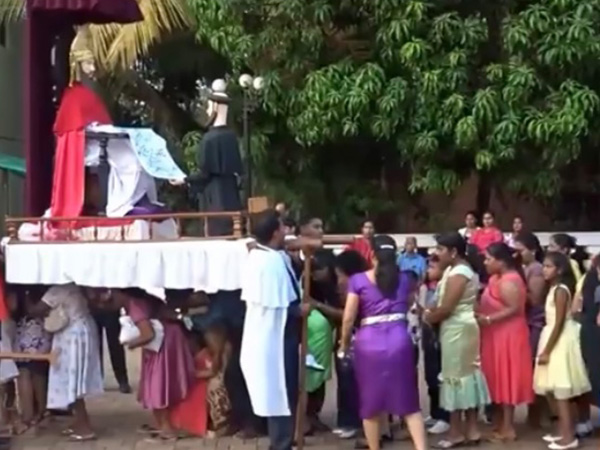
Unique processions during Lenten
Post 1500s, along with the Portuguese, came the Christian missionaries who in turn brought certain traditions that are still practiced today. These unique traditions really stand out during the special periods in the Catholic calendar year, which includes the Lenten period of 40 days.
Some parishes enact the crucifixion and the removal of the body of crucified Jesus down from the cross during the Liturgical services on Good Friday, followed by a procession. No doubt a statue of Jesus is used but the idea to contemplate the suffering of Jesus and to have moments of being sorry for wrong doings. Tied closely to the proceedings of the Lenten season and Good Friday are two unique processions.


Santanchem Pursav or Ordem Terceira is a procession of the Saints, held at St Andrew’s church, Goa Velha, every 5th Monday of the Lenten period. Started initially by the Franciscan order in the 17th century to venerate the veil of Veronica that holds the impression of Jesus’ face during his last walk to Calvary. It is believed that some missionaries might have brought the veil with them. Keeping aside the question of the authenticity of the veil, it was accompanied by a penitential procession of the Saints belonging to the Franciscan order, as a way to teach the people the simple life of the Saints. The first processions of over 60 life size statues, originated from the Pilar Church. It went through the surrounding villages and returned back to the Church. In 1835, all religious decrees were banished from the Portuguese colonies. Due to this, the procession was interrupted, statues and its vestments destroyed too. In 1868, whatever remained were transferred to St. Andrew’s Church at Goa Velha which was in the vicinity.
Presently, the procession of the Saints is a hugely attended event, and a brief about each Saint is told as they leave the Church. The first of the procession is usually the Coat of Arms, the Franciscan Society Symbol. Called the Tau Cross, there are two crucified hands, one representing Jesus and the other representing St. Francis of Assisi. Both hands together form the symbol ‘V’, which is the insignia of the Franciscan order. A little of over 30 statutes remain in the procession now. One will see many faithful bend and walk below the palanquins of the passing statues in the hope of a prayer being answered or to simply seek blessings. Initially only men were pall bearers but of late there is a participation of women as well. This is quite a feat as each of the statues weigh between 100 to 200 kgs. The procession is concluded with the ‘Veil of Veronica’ being carried by the priest. In many parishes on Good Friday, a symbolic veil of Veronica is unfurled accompanied by a song sung by a young boy or girl.







Another procession is that of ‘Procissaum das Capas Magnas’ or ‘procession of the Great Capes’, held in Se Cathedral at Old Goa. The Cathedral was built by the Dominican order that perhaps introduced this ritual. The procession in the local language of Konkani is known as ‘Xepdeche Pursanv’ which literally translates as procession of tails, referring to the black robes with a two meter tail trailing the floor. This ritual is practiced on Good Friday during the service. In an enactment, the body of Jesus is brought down from the cross, placed in a coffin and then taken to a place where the people will venerate it.
Usually, this Good Friday service is presided by the Bishop, and the Canons of Senior Priests are invited to participate in this procession wearing the black robe. They follow the coffin of Jesus that is carried by the confrades who act as pall bearers to carry the coffin. Confrades are confraternity members of the Church. They are easily identified as they wear a red cape over a white cloak called the mursa vestment. Besides the priests, these confrades participate in the services representing the faithful. The service itself is different with the singing of motets and the use of a wooden clatter replaces the bells that are otherwise used during the services on other days. The wooden clatter is a piece of wooden plank that have iron rings that make a noise to bring attention to the rituals being practiced. Bells will only be rung at Easter service again.
The Procissaum das Capas Magnas is practiced at only two places in the world, the other being at St. 5Peter’s Basilica in Rome. Good Friday is followed by Easter that celebrates the resurrection of Jesus and a new beginning for everyone again.